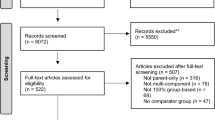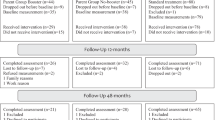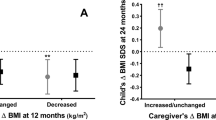Abstract
Background:
The best outcomes for treating childhood obesity have come from comprehensive family-based programmes. However there are questions over their generalizability.
Objective:
To examine the acceptability and effectiveness of ‘family-based behavioural treatment’ (FBBT) for childhood obesity in an ethnically and socially diverse sample of families in a UK National Health Service (NHS) setting.
Methods:
In this parallel group, randomized controlled trial, 72 obese children were randomized to FBBT or a waiting-list control. Primary outcomes were body mass index (BMI) and BMI s.d. scores (SDSs). Secondary outcomes were weight, weight SDSs, height, height SDSs, waist, waist SDSs, FM index, FFM index, blood pressure (BP) and psychosocial measures. The outcomes were assessed at baseline and after treatment, with analyses of 6-month data performed on an intent-to-treat (ITT) basis. Follow-up anthropometric data were collected at 12 months for the treatment group.
Results:
ITT analyses included all children with baseline data (n=60). There were significant BMI SDS changes (P<0.01) for the treatment and control groups of −0.11 (0.16) and −0.10 (1.6). The treatment group showed a significant reduction in systolic BP (−0.24 (0.7), P<0.05) and improvements in quality of life and eating attitudes (P<0.05), with no significant changes for the control group. However the between-group treatment effects for BMI, body composition, BP and psychosocial outcomes were not significant. There was no overall change in BMI or BMI SDSs from 0–12 months for the treatment group. No adverse effects were reported.
Conclusions:
Both treatment and control groups experienced significant reductions in the level of overweight, but with no significant difference between them. There were no significant group differences for any of the secondary outcomes. This trial was registered at http://www.controlled-trials.com/ under ISRCTN 51382628.
This is a preview of subscription content, access via your institution
Access options
Subscribe to this journal
Receive 12 print issues and online access
$259.00 per year
only $21.58 per issue
Buy this article
- Purchase on Springer Link
- Instant access to full article PDF
Prices may be subject to local taxes which are calculated during checkout

Similar content being viewed by others
References
Reilly JJ, Methven E, McDowell ZC, Hacking B, Alexander D, Stewart L et al. Health consequences of obesity. Arch Dis Child 2003; 88: 748–752.
Ode KL, Frohnert BI, Nathan BM . Identification and treatment of metabolic complications in pediatric obesity. Rev Endocr Metab Disord 2009; 10: 167–188.
Griffiths LJ, Parsons TJ, Hill AJ . Self-esteem and quality of life in obese children and adolescents: a systematic review. Int J Pediatr Obes 2010; 5: 282–304.
Singh AS, Mulder C, Twisk JWR, van Mechelen W, Chinapaw MJM . Tracking of childhood overweight into adulthood: a systematic review of the literature. Obes Rev 2008; 9: 474–488.
The NHS Information Centre. Health Survey for England—2008 trend tables, 2009, available at www.ic.nhs.uk/pubs/hse08trends.
Korsten-Reck U, Kromeyer-Hauschild K, Wolfarth B, Dickhuth HH, Berg A . Freiburg Intervention Trial for Obese Children (FITOC): results of a clinical observation study. Int J Obes Relat Metab Disord 2004; 29: 356–361.
Reinehr T, de SG, Toschke AM, Andler W . Long-term follow-up of cardiovascular disease risk factors in children after an obesity intervention. Am J Clin Nutr 2006; 84: 490–496.
Savoye M, Shaw M, Dziura J, Tamborlane WV, Rose P, Guandalini C et al. Effects of a weight management program on body composition and metabolic parameters in overweight children: a randomized controlled trial. JAMA 2007; 297: 2697–2704.
Jiang JX, Xia XL, Greiner T, Lian GL, Rosenqvist U . A two year family based behaviour treatment for obese children. Arch Dis Child 2005; 90: 1235–1238.
Barton SB, Walker LL, Lambert G, Gately PJ, Hill AJ . Cognitive change in obese adolescents losing weight. Obes Res 2004; 12: 313–319.
Braet C, Tanghe A, Decaluwe V, Moens E, Rosseel Y . Inpatient treatment for children with obesity: weight loss, psychological well-being, and eating behavior. J Pediatr Psychol 2004; 29: 519–529.
Epstein LH, Paluch RA, Saelens BE, Ernst MM, Wilfley DE . Changes in eating disorder symptoms with pediatric obesity treatment. J Pediatr 2001; 139: 58–65.
Oude Luttikhuis H, Baur L, Jansen H, Shrewsbury VA, O’Malley C, Stolk RP et al. Interventions for treating obesity in children. Cochrane Database Syst Rev 2009; 1: CD001872.
Epstein LH, Paluch RA, Gordy CC, Dorn J . Decreasing sedentary behaviors in treating pediatric obesity. Arch Pediatr Adolesc Med 2000; 154: 220–226.
Epstein LH, Paluch RA, Gordy CC, Saelens BE, Ernst MM . Problem solving in the treatment of childhood obesity. J Consult Clin Psychol 2000; 68: 717–721.
Epstein LH, McCurley J, Wing RR, Valoski A . Five-year follow-up of family-based behavioral treatments for childhood obesity. J Consult Clin Psychol 1990; 58: 661–664.
Epstein LH, Valoski A, Wing RR, McCurley J . Ten-year outcomes of behavioral family-based treatment for childhood obesity. Health Psychol 1994; 13: 373–383.
Gunnarsdottir T, Njardvik U, Olafsdottir AS, Craighead L, Bjarnason R . Childhood obesity and co-morbid problems: effects of Epstein's family-based behavioural treatment in an Icelandic sample. J Eval Clin Pract 2011; e-pub ahead of print 6 January 2011; doi:10.1111/j.1365-2753.2010.01603.x.
Herrera EA, Johnston CA, Steele RG . A comparison of cognitive and behavioral treatments for pediatric obesity. Child Health Care 2004; 33: 151–167.
Levine MD, Ringham RM, Kalarchian MA, Wisniewski L, Marcus MD . Is family-based behavioural weight control appropriate for severe pediatric obesity? Int J Eat Disord 2001; 30: 318–328.
Epstein LH . Family-based behavioural intervention for obese children. Int J Obes Relat Metab Disord 1996; 20 (Suppl 1): S14–S21.
Edwards C, Nicholls D, Croker H, Van ZS, Viner R, Wardle J . Family-based behavioural treatment of obesity: acceptability and effectiveness in the UK. Eur J Clin Nutr 2006; 60: 587–592.
Moher D, Hopewell S, Schulz KF, Montori V, Gotzsche PC, Devereaux PJ et al. CONSORT 2010 explanation and elaboration: updated guidelines for reporting parallel group randomised trials. BMJ 2010; 340: c869.
Schulz KF, Altman DG, Moher D . CONSORT 2010 statement: updated guidelines for reporting parallel group randomised trials. BMJ 2010; 340: c332.
Craig P, Dieppe P, Macintyre S, Michie S, Nazareth I, Petticrew M . Developing and evaluating complex interventions: the new medical research council guidance. BMJ 2008; 337: a1655.
Cole TJ, Bellizzi MC, Flegal KM, Dietz WH . Establishing a standard definition for child overweight and obesity worldwide: international survey. BMJ 2000; 320: 1240–1243.
Food Standards Agency. eatwell plate, Crown Copyright Food Standards Agency, UK, 2007.
O’Donovan G, Blazevich AJ, Boreham C, Cooper AR, Crank H, Ekelund U et al. The ABC of physical activity for health: a consensus statement from the British Association of Sport and Exercise Sciences. J Sports Sci 2010; 28: 573–591.
Cole TJ, Faith MS, Pietrobelli A, Heo M . What is the best measure of adiposity change in growing children: BMI, BMI %, BMI z-score or BMI centile? Eur J Clin Nutr 2005; 59: 419–425.
Freeman JV, Cole TJ, Chinn S, Jones PR, White EM, Preece MA . Cross-sectional stature and weight reference curves for the UK, 1990. Arch Dis Child 1995; 73: 17–24.
Cole TJ, Freeman JV, Preece MA . Body mass index reference curves for the UK, 1990. Arch Dis Child 1995; 73: 25–29.
McCarthy HD, Jarrett KV, Crawley HF . The development of waist circumference percentiles in British children aged 5.0–16.9 y. Eur J Clin Nutr 2001; 55: 902–907.
Haroun D, Wells JCK, Williams JE, Fuller NJ, Fewtrell MS, Lawson MS . Composition of the fat-free mass in obese and nonobese children: matched case–control analyses. Int J Obes 2005; 29: 29–36.
Wells JCK, Fuller NJ, Fewtrell MS, Elia M, Cole TJ . Four-component model of body composition in children: density and hydration of fat-free mass and comparison with simpler models. Am J Clin Nutr 1999; 69: 904–912.
VanItallie TB, Yang MU, Heymsfield SB, Funk RC, Boileau RA . Height-normalized indices of the body's fat-free mass and fat mass: potentially useful indicators of nutritional status. Am J Clin Nutr 1990; 52: 953–959.
Jackson LV, Thalange NK, Cole TJ . Blood pressure centiles for Great Britain. Arch Dis Child 2007; 92: 298–303.
Duke PM, Litt IF, Gross RT . Adolescents’ self-assessment of sexual maturation. Pediatrics 1980; 66: 918–920.
Harter S . The perceived competence scale for children. Child Dev 1982; 53: 87–97.
Kovacs M . Rating scales to assess depression in school-aged children. Acta Paedopsychiatr 1981; 46: 305–315.
Goodman R . The Strengths and Difficulties Questionnaire: a research note. J Child Psychol Psychiatry 1997; 38: 581–586.
Varni JW, Seid M, Kurtin PS . PedsQL 4.0: reliability and validity of the Pediatric Quality of Life Inventory version 4.0 generic core scales in healthy and patient populations. Med Care 2001; 39: 800–812.
Garner DM, Olmsted MP, Bohr Y, Garfinkel PE . The eating attitudes test: psychometric features and clinical correlates. Psychol Med 1982; 12: 871–878.
Maloney MJ, McGuire JB, Daniels SR . Reliability testing of a children's version of the Eating Attitude Test. J Am Acad Child Adolesc Psychiatry 1988; 27: 541–543.
Gibson EL, Wardle J, Watts CJ . Fruit and vegetable consumption, nutritional knowledge and beliefs in mothers and children. Appetite 1998; 31: 205–228.
Ware JH . Interpreting incomplete data in studies of diet and weight loss. N Engl J Med 2003; 348: 2136–2137.
Viner R, Nicholls D . Managing obesity in secondary care: a personal practice. Arch Dis Child 2005; 90: 385–390.
Schwimmer JB, Burwinkle TM, Varni JW . Health-related quality of life of severely obese children and adolescents. JAMA 2003; 289: 1813–1819.
Rudolf M, Christie D, McElhone S, Sahota P, Dixey R, Walker J et al. WATCH IT: a community based programme for obese children and adolescents. Arch Dis Child 2006; 91: 736–739.
Hoare P, Elton A, Greer A, Kerley S . The modification and standardisation of the Harter self-esteem questionnaire with Scottish school children. Eur Child Adolesc Psychiatry 1993; 2: 19–33.
Sacher PM, Kolotourou M, Chadwick PM, Cole TJ, Lawson MS, Lucas A et al. Randomized controlled trial of the MEND program: a family-based community intervention for childhood obesity. Obesity 2010; 18 (Suppl 1): S62–S68.
Ford AL, Hunt LP, Cooper A, Shield JPH . What reduction of BMI SDS is required in obese adolescents to improve body composition and cardiometabolic health? Arch Dis Child 2010; 95: 256–261.
Reinehr T, Adler W . Changes in the atherogenic risk profile according to degree of weight loss. Arch Dis Child 2004; 89: 419–422.
Skelton JA, Beech BM . Attrition in paediatric weight management: a review of the literature and new directions. Obes Rev 2010; 12: e273–e281; doi.10.1111/j.1467-789X.2010.00803.x.
Hughes AR, Stewart L, Chapple J, McColl JH, Donaldson MDC, Kelnar CJH et al. Randomized, controlled trial of a best-practice individualized behavioral program for treatment of childhood overweight: Scottish Childhood Overweight Treatment Trial (SCOTT). Pediatrics 2008; 121: e539–e546.
Ford AL, Bergh C, Sodersten P, Sabin MA, Hollinghurst S, Hunt LP et al. Treatment of childhood obesity by retraining eating behaviour: randomised controlled trial. BMJ 2009; 340: b5388.
Epstein LH, Paluch R, Roemmich J, Beecher M . Family-based obesity treatment, then and now: twenty five years of pediatric obesity treatment. Health Psychol 2007; 26: 381–391.
Wifley DE, Tibbs TL, Van Buren DJ, Reach KP, Walker MS, Epstein LH . Lifestyle interventions in the treatment of childhood overweight: a meta-analytic review of randomised controlled trials. Health Psychol 2007; 26: 521–532.
Schwartz RP, Hamre R, Dietz WH, Wasserman RC, Slora EJ, Myers EF et al. Office-based motivational interviewing to prevent childhood obesity: a feasibility study. Arch Pediatr Adolesc Med 2007; 161: 495–501.
Magarey AM, Perry RA, Baur LA, Steinbeck KS, Sawyer M, Hills AP et al. A parent-led family-focused treatment program for overweight children aged 5 to 9 years: the PEACH RCT. Pediatrics 2011; 127: 214–222.
Epstein LH, Wing RR, Koeske R, Valoski A . Effect of parent weight on weight loss in obese children. J Consult Clin Psychol 1986; 54: 400–401.
White MA, Martin PD, Newton RL, Walden HM, York-Crowe EE, Gordon ST et al. Mediators of weight loss in a family-based intervention presented over the internet. Obesity 2004; 12: 1050–1059.
Golan M, Kaufman V, Shahar DR . Childhood obesity treatment: targeting parents exclusively v. parents and children. Br J Nutr 2006; 95: 1008–1015.
Golley RK, Magarey AM, Baur LA, Steinbeck KS, Daniels LA . Twelve-month effectiveness of a parent-led, family-focused weight-management program for prepubertal children: a randomized, controlled trial. Pediatrics 2007; 119: 517–525.
Acknowledgements
We thank the families who took part, and the clinical and administrative staff at Great Ormond Street Hospital and the research staff at UCL for contributing their time and effort to the study. The trial was funded by Cancer Research UK, Great Ormond Street Hospital and Weight Concern. All authors contributed to the study design and protocol. JW obtained the funding for the study. HC was responsible for the day-to-day running of the study and for recruitment; supervised the running of treatment sessions and clinical staff; analysed the data; interpreted the results and drafted the paper. RMV was responsible for the medical assessment and care of children, and analysed data and interpreted the results. DN had overall clinical responsibility for families, analysed data and interpreted the results. DH performed the body composition and anthropometric measurements. PC and CE contributed to the supervision of treatment sessions and clinical staff. JCKW provided the protocol and facilities for the body composition measures. All authors reviewed the manuscript. JW is the guarantor.
Author information
Authors and Affiliations
Corresponding author
Ethics declarations
Competing interests
The authors declare no conflict of interest.
Additional information
Supplementary Information accompanies the paper on International Journal of Obesity website
Supplementary information
Rights and permissions
About this article
Cite this article
Croker, H., Viner, R., Nicholls, D. et al. Family-based behavioural treatment of childhood obesity in a UK national health service setting: randomized controlled trial. Int J Obes 36, 16–26 (2012). https://doi.org/10.1038/ijo.2011.182
Received:
Revised:
Accepted:
Published:
Issue Date:
DOI: https://doi.org/10.1038/ijo.2011.182
Keywords
This article is cited by
-
The effect of psychological interventions targeting overweight and obesity in school-aged children: a systematic review and meta-analysis
BMC Public Health (2023)
-
A new application of TMR: A study on implicit self-esteem
Current Psychology (2023)
-
Effectiveness of mobile application on changing weight, healthy eating habits, and quality of life in children and adolescents with obesity: a randomized controlled trial
BMC Pediatrics (2021)
-
Effectiveness and process evaluation in obesity and type 2 diabetes prevention programs in children: a systematic review and meta-analysis
BMC Public Health (2021)
-
Identification and evaluation of risk of generalizability biases in pilot versus efficacy/effectiveness trials: a systematic review and meta-analysis
International Journal of Behavioral Nutrition and Physical Activity (2020)



